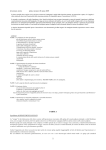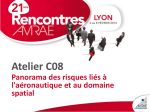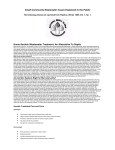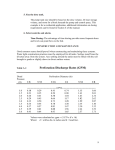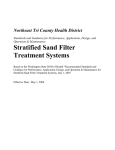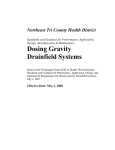Download Aerobic Treatment Units: An Alternative to Septic Systems
Transcript
SUMMER 2005 Vol. 16, No. 3 Small Community Wastewater Issues Explained to the Public Aerobic Treatment Units: An Alternative to Septic Systems any homes in the U.S. are located in small or rural communities where houses are spaced widely apart. In these communities, central sewerage systems are often not cost-effective, so many homeowners rely on septic systems or other systems that treat and dispose of household wastewater onsite. Some homes for which septic systems are not a good option, because of site or soil conditions, rely on individual aerobic systems for wastewater treatment. M Aerobic systems are similar to septic systems in that they both use natural processes to treat wastewater. But unlike septic (anaerobic) treatment, the aerobic treatment process requires oxygen. Aerobic treatment units (ATUs), therefore, use a mechanism to inject and circulate air inside the treatment tank. This mechanism requires electricity to operate. For this reason, ATUs cost more to operate and need more routine maintenance than most septic systems. However, when properly operated and maintained, aerobic systems can provide a highquality wastewater treatment alternative to septic systems. (Aerobic treatment units are also known as ATUs, home aeration systems, and aeration systems.) Why choose aerobic treatment? Septic tank-soil absorption systems are relatively inexpensive and are easy to maintain. They are the most common onsite wastewater treatment systems used in rural areas. However, there are many households for which a traditional septic system may not be the best wastewater treatment option. Regulations are changing to accept aerobic treatment systems as part of the normal approval process. For example, septic systems are not suitable for every lot. In fact, approximately two-thirds of all the land area in the U.S. is estimated to be unsuitable for the installation of septic systems. Some homes may not have enough land area or appropriate soil conditions to accommodate a conventional soil absorption This issue of Pipeline is an update to the Winter 1996 issue, Vol. 7, No. 1. drainfield. In some communities, the water table is too high to allow the drainfield to give adequate treatment to the wastewater before it reaches groundwater. Other site-related concerns include homes located on small lots or on lots close to a body of water. The wastewater treated by a septic system is often not of high enough quality to be discharged very close to a body of water. But one of the most common reasons that aerobic wastewater treatment units are chosen by communities is to replace failing septic systems. Failing septic systems are a major source of groundwater pollution in some Aerobic Treatment Units areas. If a failed septic system needs to be replaced, or if a site is inappropriate for conventional systems, aerobic wastewater treatment becomes a viable option. Installation of aerobic units in new construction has also become a common practice. In some cases, regulations allow ATUs to be installed in areas where the soils cannot handle septic tank effluent, because they are less likely to cause soil clogging. Many states are requiring ATU effluent to be disinfected before direct discharge. That is, when the effluent is properly disinfected with a chlorinator for example, it may be sent directly to a surface water body, such as a stream. This is a typical remedy for failing septic systems in many Pipeline is published quarterly by the National Environmental Services Center at West Virginia University, P.O. Box 6064, Morgantown, WV 26506-6064 areas. Additionally, aerated effluent has been shown to renovate a clogged drainfield. Upgrading a septic tank to an ATU can rejuvenate an existing drainfield and extend its life. There are, of course, some drawbacks to ATUs. The basic unit is more expensive to own and operate than a septic tank and requires more maintenance. The solids must be pumped out at much more frequent intervals, and the electrical-mechanical parts must be maintained. Most ATUs are sold with a two-year service contract, covering inspections and maintenance. Manufacturers and regulators recommend that such a contract be extended for the life of the unit. ATUs are not the solution for every situation, but they do offer a reasonable alternative for difficult sites that require onsite wastewater treatment. This issue of Pipeline focuses on individual home aerobic units as one alternative for onsite wastewater treatment. How Aerobic Treatment Works Aerobic systems treat wastewater using natural processes that require oxygen. Bacteria that thrive in oxygen-rich environments break down and digest the wastewater inside the aerobic treatment unit as they are suspended in the liquid. Like most onsite systems, aerobic systems treat the wastewater in stages. Sometimes the wastewater receives pretreatment before it enters the aerobic unit, and the treated wastewater leaving the unit requires additional treatment or disinfection before being returned to the environment. Such a variety of designs exists for home aerobic units and systems that it is impossible to describe a typical system. Instead, it is more practical to discuss how some common design features of aerobic systems work and the different stages of aerobic treatment. Pipeline is funded through a grant from the U.S. Environmental Protection Agency, Washington, D.C. Steve Hogye — Project Officer Municipal Support Division, Office of Wastewater Management National Small Flows Clearinghouse West Virginia University, Morgantown, WV Rick Phalunas — Interim Executive Director Marilyn Noah — Editor Jennifer Hause — Technical Advisor Clement Solomon — Technical Advisor John Fekete — Senior Graphic Designer Jamie Bouquot — Graphic Designer Permission to quote from or reproduce articles in this publication is granted when due acknowledgement is given. Please send a copy of the publication in which information was used to the Pipeline editor at the address above. an equal opportunity/affirmative action institution ISSN 1060-0043 The contents of this newsletter do not necessarily reflect the views and policies of the U.S. Environmental Protection Agency, Printed on recycled paper nor does the mention of trade names or commercial products constitute endorsement or recommendation for use. Figure 1 An example of a possible aerobic unit design 2 PIPELINE – Summer 2005; Vol.16, No. 3 Adapted with permission from Pennsylvania State University College of Agriculture Extension Service National Environmental Services Center (800) 624-8301 or (304) 293-4191 Aerobic Treatment Units Pretreatment Some aerobic systems include a pretreatment step to reduce the amount of solids in the wastewater going into the aerobic unit. Solids include toilet paper and other materials that are put down the drain or flushed into the system. Too much solid material can clog the unit and prevent effective treatment. Some pretreatment methods include a septic tank, a primary settling compartment in the treatment unit, or a trash tank. The trash tank removes solid materials that the bacteria cannot breakdown. Pretreatment greatly improves a unit’s performance. TING Treatment The main function of the aerobic unit is to collect and treat household wastewater, which includes all water from toilets, bathtubs, showers, sinks, and laundry. Aerobic units themselves come in many sizes and shapes. The process most aerobic units use to treat wastewater is referred to as suspended growth. These units include a main compartment called an aeration chamber in which air is mixed with the wastewater. Because most home aerobic units are buried underground like septic tanks, the air must be forced into the aeration chamber by an air blower or a compressor. The forced air mixes with wastewater in the aeration chamber, and the oxygen supports the growth of aerobic bacteria that digest the solids in the wastewater. This mixture of wastewater and oxygen is called the mixed liquor. The treatment occurring in the mixed liquor is referred to as suspended growth because the bacteria grow and die as they are suspended in the liquid unattached to any surface. Unfortunately, the bacteria cannot digest all of the solids in the mixed liquor, and these solids PIPELINE – Summer 2005; Vol.16, No. 3 Figure 2 Another example of a possible aerobic unit design Adapted with permission from Pennsylvania State University College of Agriculture Extension Service eventually settle out as sludge. Many aerobic units include a secondary chamber called a settling chamber or clarifier where excess solids can settle. (See Figure 1.) Other designs allow the sludge to accumulate at the bottom of the tank. (See Figure 2.) In aerobic units designed with a separate settling compartment, the sludge returns to the aeration chamber (either by gravity or by a pumping device). The sludge contains bacteria that also aid in the treatment process. Although, in theory, the aerobic treatment process should eventually be able to consume the sludge completely, in practice, the sludge does build up and will need to be pumped out frequently so that solids don’t clog the unit. Flow Design The wastewater flow and quantity received by the aerobic unit differs from design to design. Continuous flow designs simply allow the wastewater to flow through the unit at the same rate that it leaves the home. Other designs employ devices (such as pretreatment tanks, surge chambers, and baffles) to control the amount of the incoming flow. Batch process designs use pumps or siphons to control the amount of wastewater in the aeration tank or to discharge the treated wastewater in controlled amounts after a certain period of time. Controlling the flow of wastewater helps to protect the treatment process. When too much wastewater is flushed into the system all at once, it can become overburdened, and the quality of treatment can suffer. The disadvantages to mechanical flow control devices are that, like all mechanical components, they need maintenance and run the risk of malfunctioning. Homeowners can help their system’s performance by conserving water. Leaking faucets and run- 3 National Environmental Services Center (800) 624-8301 or (304) 293-4191 Aerobic Treatment Units WARNING SIGNS of Aerobic System Problems Alarms or lights going off Any changes in the system’s normal operating sound Any changes in the normal color of the wastewater in the aeration chamber (for example, if the color is greyish brown rather than chocolate brown, this can sometimes indicate problems) Excessive solids, foam, or scum in the unit Plumbing backups Sewage odors in the house or yard ning toilets should be repaired, and washing machines and dishwashers should be used only when full. Installing water saving devices in toilets, faucets, and showers can reduce water use by up to 50 percent. Homeowners should try to space out activities requiring heavy water use (like laundry) to avoid overloading their systems. Final Treatment and Dispersal Although properly operated and maintained aerobic units are very effective, the wastewater leaving the units is not ready to be returned to the environment and must receive final treatment or disinfection. Methods for final treatment include discharge to a soil absorption field, a sand filter, an evapotranspiration bed, or drip irrigation. Sometimes, the wastewater receives disinfection before being discharged to the soil or directly to a body of water. Your health department is familiar with local regulations and the treatment options that are best in your area and for your property. Soil absorption fields (or drainfields) are the most common method of final treatment used for septic systems. An aerobic unit can sometimes help to prolong the life of a drainfield. The amount of dissolved oxygen contained in wastewater from an aerobic unit can help the growth of microorganisms that treat the wastewater in the soil and can help prevent the pores in the soil from clogging. However, when aerobic units malfunction, they can release solids that can clog the drainfield, which may cancel out any potential benefits. Evapotranspiration beds are a less common method of final treatment and use vegetation and evaporation to naturally treat the wastewater. Drip irrigation is another less commonly used method to treat and disperse of wastewater. Sand filters are sometimes used to treat the wastewater from aerobic units. The wastewater is pumped evenly over several layers of sand and gravel, which are located either above or below ground. As with soil treatment systems, the purification process is aided by bacteria that occur naturally in the sand. Disinfection is another method of treatment commonly used with surface-discharged aerobic units. Some units have the disinfection process incorporated into the unit design. In some cases, disinfection may be the only treatment required of the wastewater from an aerobic unit before the water is released into the environment. One disadvantage of this method is the added cost of the disinfectants and maintenance. Chlorination is the most common method of disinfection. However, ultra-violet (UV) disinfection is gaining prominence. The use of UV light is often preferable since it does not have any unwanted residual effect as the use of chlorine can. The Spring 2004 issue of Pipeline provides a complete description of the disinfection treatment process and the various technologies available Other Design Considerations Controls and Alarms Most aerobic units have controls that can be switched on and off by the homeowner in case of emergency. Aerobic units also are required to have alarms to alert the homeowner of malfunctions. Depending on the design of the system, controls and alarms can be located either inside or outside the home, and alarms can be visible, audible, or both. Homeowners should make sure that controls and alarms are always protected from corrosion, and that the aerobic unit is turned back on if there is a power outage or if it is turned off temporarily. Size Aerobic units should be large enough to allow enough time for the solids to settle and for the wastewater to be treated. The size of most units range from 300 to 1,500 gallons per day, but local regulations often require that the unit be at least large enough to handle 500 gallons of wastewater per day. The needed size of an aerobic unit is often estimated the same way the size of a septic tank is estimated, by the number of bedrooms (not bathrooms) in the house. It is assumed that each person will use approximately 50 to 100 gallons of water per day, 4 PIPELINE – Summer 2005; Vol.16, No. 3 National Environmental Services Center (800) 624-8301 or (304) 293-4191 Aerobic Treatment Units and that each bedroom can accommodate two people. When calculated this way, a three-bedroom house will require a unit with a capacity of 300 to 600 gallons per day. Some health departments require that aerobic units be sized at least as large as a septic tank in case the aerobic unit malfunctions and oxygen doesn’t mix with the wastewater. In such cases, the aerobic unit will work as a septic tank—which will, at least, provide partial treatment for the wastewater. Temperature Lower temperatures tend to slow down most biological processes, and higher temperatures tend to speed them up. The aerobic process itself creates heat, which, along with the temperature of the wastewater, may help to keep the treatment process active. However, cold weather can have adverse effects on the performance of aerobic units. In one study of aerobic units, there were problems when the temperature of the wastewater inside some of the units fell below 15 degrees Celsius (59 degrees Fahrenheit). Insulating around the units avoids these problems. Your health department should know whether aerobic systems are suitable for your area. Aerobic System Maintenance It is important that mechanical components in aerobic systems receive regular inspection and maintenance. For example, mechanical aerators sometimes need to be oiled, and vanes, filters, and seals may need to be replaced. In most cases, homeowners do not have the expertise to inspect, repair, and maintain their own systems. If your unit carries the NSF International approval, it will include the first two years of service visits with the purchase price and an option to renew the service contract after two years (Refer to page 7 for more information about NSF.) It is a good idea for homeowners to renew their service agreements after two years, or to find another service organization to take over the job. In addition to routine maintenance, NSF requires service contractors to stock replacement parts for mechanical components and to be available for emergency servicing. Under the original two-year agreement, failed equipment is replaced at no additional cost to the homeowner. The service contract may or may not cover such problems as damage from power failures, breaking or crushing of pipes leading to and from the system, flooding, fires, homeowner misuse, and other catastrophes beyond the control of the manufacturer. The dealer or other independent service organization that has an agreement with the manufacturer will carry out the service visit. In some cases, health departments will have management programs, such as sanitary districts, for aerobic systems and other onsite systems in their area. What To Expect at a Typical Service Visit The first service visit should be scheduled immediately after the system is installed to make sure that everything is working correctly. The service contractor may also arrange a meeting with the homeowner to go over issues, such as proper operation, what to do in case of emergency, etc. For seasonal properties, homeowners will need to know how to shut the system down in the off season and start it again when needed. After the first visit, the maintenance service contract is issued to the homeowner. Cost Considerations The cost of aerobic treatment varies depending on factors, such as design, size, location, and operation and maintenance requirements. Some of the factors affecting the cost of aerobic treatment are as follows: • unit price, • cost of unit installation and electricians’ fees, • cost of construction of the drainfield or cost of other method of additional treatment if required, • cost of electricity (per year), • maintenance service contract fee (per year), and • cost of disinfection (if applicable). The price of some of these factors, such as unit price, may be adversely affected by the lack of demand for aerobic systems in certain areas. Installation costs may be higher for aerobic units than for septic tanks because of the electrical work required. All of these factors need to be carefully considered when determining the costeffectiveness of aerobic treatment versus other treatment methods. Your local health official can help you evaluate your options. The maintenance contract may include at least two service visits per year for the next two years. The number of visits and service performed will differ from unit to unit and location to location depending on manufacturers’ recommendations and local regulations. During a typical visit, the service provider will remove the unit’s cover and check its general appearance. He or she will check pipes and the inside of the aeration chamber, and will note the 5 PIPELINE – Summer 2005; Vol.16, No. 3 National Environmental Services Center (800) 624-8301 or (304) 293-4191 Aerobic Treatment Units Six-county survey recommends mandatory lifetime maintenance contracts for ATU systems In 1998, a survey was conducted to determine if the ATU systems in six West Virginia counties were meeting health and environmental regulations. Effluent samples from approximately 419 units were tested for biochemical oxygen demand (BOD5), total suspended solids (TSS), and fecal coliforms. Data from the study guided state policy with regard to the monitoring of ATUs on existing sites and the permitting of aerobic units for use in new construction. When 92 percent of 419 ATU systems were found to be discharging effluent of unacceptable quality, poor maintenance practices were determined to be the main cause. Researchers from West Virginia University concluded that ATUs require proper maintenance for the life of the system to operate reliably and produce a high quality effluent. Conclusions were: • ATUs with good maintenance histories exceeded the TSS and BOD5 limits. • Disinfection of effluent was inadequate and must be improved to avoid potential public health threats. • Inadequate maintenance was common. The authors recommended safeguards be put in place to ensure effective continuous operation of these systems. • Mandatory lifetime maintenance should be required for ATU systems. Source: Sexstone, Alan, et. al.“A Survey of Home Aerobic Treatment Systems Operating in Six West Virginia Counties,” Small Flows Quarterly, Fall 2000, National Environmental Service Center. Available for download at www.nesc.wvu.edu/nsfc/sfqarchive frame.html. Aerobic wastewater treatment may be a good option when... • The soil quality is not appropriate for a septic system. • There is high groundwater or shallow bedrock. • A higher level of wastewater treatment is required. • A septic system has failed. • There is not enough land available for a septic system. 6 PIPELINE – Summer 2005; Vol.16, No. 3 appearance of the wastewater inside the unit and its color and odor. If the unit includes a chlorinator, this too will be checked and may be cleaned. Samples may be taken of the mixed liquor from the aeration chamber, as well as the final treated wastewater. The operator will also check to see that all mechanical parts, alarms, and controls are in working order, and that solids are pumped from the system if needed. The service provide will inspect the soil absorption field, sand filter, or other method of final treatment. Recordkeeping It is a good idea for the homeowner or the service provider to keep detailed records about the system and service visits. NSF-approved units are required to include a user’s manual that describes such things as the manufacturer’s recommendations for the unit, the system design, how to operate and maintain it, as well as how to tell if it is working properly. The state permitting license, the date the system was installed, the type of disinfection used, and any modifications made to the system should also be recorded. Other important information to keep on hand includes where to contact the owner if nobody is home, where to find a key to the system, and the schedule for service visits. Homeowners should keep their own copies of all records and permits. A convenient record-keeping folder is available from the National Environmental Services Center. Details about how to obtain this homeowner’s packet may Reprint be found on Info page 8. Readers are encouraged to reprint Pipeline articles in local newspapers or include them in flyers, newsletters, or educational presentations. Please include the name and phone number of the National Environmental Service Center (NESC) on the reprinted information and send us a copy for our files. If you have any questions about reprinting articles or about any of the topics discussed in this newsletter, please contact the NESC at (800) 624-8301. Aerobic Treatment Units NSFI provides industry standards Aerobic treatment systems are not accepted in all areas. Regulations for onsite systems can vary from state to state and from one local government to the next. the homeowner. Manufacturers must also offer the homeowner the option of renewing the service contract after the two years. One possible reason that the acceptance of aerobic systems has been slow in some communities may be that local regulators don’t have much experience with them. Unless aerobic systems are already in use locally, there is little opportunity for officials to become familiar with their performance in different situations. A major reason that aerobic systems are not more widely used is concern about improper operation and maintenance by homeowners. Aerobic systems require regular maintenance, and abuse or neglect can easily lead to system failure. In answer to these concerns, NSF International (formerly the National Sanitation Foundation) has tested aerobic units according to the requirements of ANSI/NSF Standard 40. NSF International is a nonprofit organization devoted to the protection of public health and the environment through the development of product standards, product evaluations, research, education, and training. The American National Standards Institute (ANSI) is the recognized accreditor in the U.S. for organizations that develop consumer standards and for those that provide independent product evaluations. NSF is accredited by ANSI for both of these areas of service. Aerobic units that satisfy the requirements of ANSI/NSF Standard 40 may carry the NSF mark (see mark above). In addition to testing their units, NSF requires manufacturers to include the cost of the first two years of service in the price of purchase. During this initial service contract, each piece of equipment must be serviced a minimum of two times per year, and emergency service must be available to PIPELINE – Summer 2005; Vol.16, No. 3 Although the U.S. EPA permit program does not apply to onsite discharge, “Class I” listed units have been shown to produce an equivalent quality effluent when tested for six months at their design-rated capacities. This Standard contains minimum requirements for residential wastewater treatment systems having single, defined discharge points and rated treatment capacities between 1514 liters per day (400 gallons per day) and 5678 liters per day (1500 gallons per day). A copy of Standard 40 may be purchased for $90.00. NSF/ANSI Standard 46 In most cases, the service contract is carried out by the dealer selling the aerobic unit, representing the manufacturer. Standard 40 details what type of service is to be performed and what records need to be kept. Both the manufacturers and their distributors are inspected annually by NSF to ensure continued compliance with the requirements. Some state and local governments that allow aerobic treatment require that units carry the NSF approval. Your local health department will be familiar with the regulations and permit requirements for your area, as well as which onsite options are best for your particular property. NSF/ANSI Standard 40 – Residential Wastewater Treatment Systems Standard 40, relating to residential wastewater treatment systems, requires six months of performance testing incorporating stress tests to simulate wash day, working parent, power outage, and vacation conditions. Standard 46, relating to components of wastewater treatment systems, applies to any wastewater treatment product not covered by Standards 40 and 41. Standard 46 was developed to replace NSF Criteria C-9, which was withdrawn in 2000. Standard 46 currently includes performance evaluations for grinder pumps, septic tank effluent filters, chlorination devices, and UV disinfection devices. As product users, regulatory officials, and manufacturers identify the need for additional performance evaluations for other classes of wastewater treatment products, the NSF Joint Committee on Wastewater Technology will develop the evaluations and add them to Standard 46. A copy of Standard 46 may be purchased for $75.00. NSF also produces a complete listing of approved systems titled NSF Listings of Wastewater Treatment Units. This listing may be downloaded at www.nsf.org/Certified/ Wastewater/Listings.asp? You may search the listing by product name, manufacturer, or product standard. For more information or to order these products, contact NSF International at (800) NSF-MARK or (800) 673-6275. 7 National Environmental Services Center (800) 624-8301 or (304) 293-4191 RELATED NESC Products Pipeline, Spring 2004. The Disinfection Question – Answers for Onsite Systems #SFPLN27 Disinfection is generally required with onsite treatment systems where the effluent is to be surface discharged to prior to some other immediate reuse of effluent. This issue, titled “The Disinfection Question – Answers for Onsite Systems”, describes two of the most common methods of disinfection used with onsite systems: chlorine and ultraviolet light. Pros and cons of the use of these methods are discussed. Information about the dosage and design parameters of each type of disinfection process are presented. May be downloaded as a pdf file at www.nesc.wvu.edu/nsfc/plarchiveframe.html Environmental Technology Initiative Fact Sheets: Ultraviolet Disinfection #WWFSGN98 (1998) Chlorine Disinfection #WWFSGN99 (1998) Ozone Disinfection #WWFSGN100 (1998) Homeowner Onsite System Recordkeeping folder #WBLPE37 Homeowner’s Septic Tank Information Package #WWPKPE28 On-Site Wastewater Treatment System Fact Sheet #WWFSGN160 Pipeline, Summer 2001.Gravelless and Chamber Systems: Alternative Drainfield Designs #SFPLN26 The Summer issue of Pipeline presents an overview of gravelless and contour drainfield systems for onsite wastewater treatment and dispersal. The issue compares the two technologies with conventional drainfields. It also explains their operation and maintenance, and advantages and disadvantages. A case study about a chamber system used in a West Virginia School is included. May be downloaded as a pdf file at www.nesc.wvu.edu/nsfc/plarchiveframe.html EPA Decentralized Systems Technology Fact Sheet #WWFSGN170 To order, call (800)624-8301 for prices and availability. ADDRESS SERVICE REQUESTED National Environmental Services Center WVU Research Corporation West Virginia University P.O. Box 6064 Morgantown, WV 26505-6064 NONPROFIT ORGANIZATION U.S. POSTAGE PAID PERMIT NO. 34 MORGANTOWN, WV











